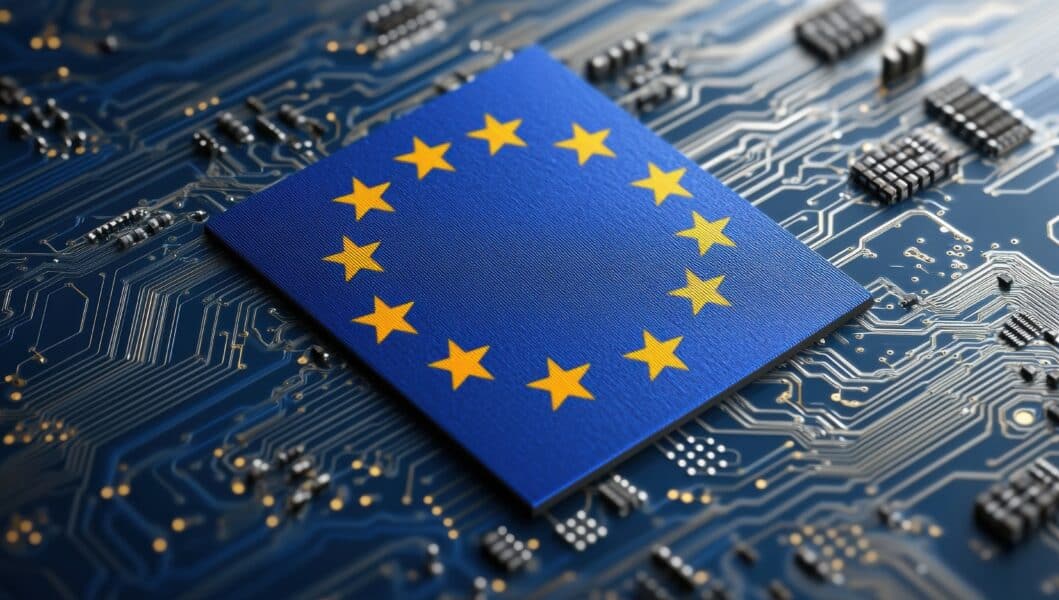“Stop consuming American products!” This rather blunt slogan seems to have been making the rounds following Donald Trump’s announcement of customs tariffs of 20% on imports from Europe. The markets reacted sharply and producers on the European continent were concerned. The European Union was quick to respond, banking on negotiations that it believed were still possible.
Although the situation has been on hold for a few months, it has nevertheless highlighted a certain trade imbalance between the two historic allies. Americans buy far more European products than Europeans buy American products, with a trade surplus of $227bn1. Coca-Cola and McDonald’s, for example, American icons, have most of their production in Europe. This makes it difficult for the United States to retaliate with customs tariffs in the negotiations.
Our dependence on the American market is more subtle, nestled in the intangible realm of digital technology. Now that we have seen how deeply rooted this dependence has become, to the point where it influences our internal policies, Valérie Peugeot, an affiliate professor at Sciences Po Paris whose work focuses on digital commons, offers some insights on how we might break free from this quasi-monopoly. “In the digital sphere, we have left the field open to the United States, which has made significant investments in strategic technological choices,” she explains. “This has been the case since the beginning of the Internet, as demonstrated by the little-known story of Louis Pouzin2.”
“Europe regulates, the United States innovates?”
The digital economy has followed a somewhat unusual trajectory, initially arousing the mistrust of investors. Amazon is a good example of this, with years of financial losses that ultimately led to the emergence of one of the most powerful companies in the world. This growth model does not aim for immediate profitability but is rather based on the “winner takes all” principle, which allows for long-term dominance. This could explain the reluctance of European public authorities to get involved: “In the digital sector, unlike what has been done with companies such as Airbus, there has been a lack of industrial policy on Europe’s part,” says Valérie Peugeot. “Even though the United States has historically been considered the champion of economic liberalism, in reality there has always been massive public investment in digital technology. Behind the Internet, for example, there was DARPA3 and its £25 million investment in ARPANET from 1966 to 1975 – the forerunner of the web.”
All this leads to the widespread and widely refuted idea that the United States finances innovation while the European Union regulates. “On the one hand, Europe also invests heavily in research through its framework programmes. Furthermore, all the European regulations adopted recently, such as the AI Act (regulation of artificial intelligence), the DGA (regulation on data governance), the DMA (Digital Markets Act) and the DSA (Digital Services Act) certainly illustrate a European desire to regulate this market, in particular to resist its tendency towards monopolies, while helping to create legal certainty. Because the law is also a factor in business security.”
The Health Data Hub, a French example
It seems that Europe has taken too long to recognise its “ultra-dependence” on American digital technology. The example used by Valérie Peugeot to support this view is the Health Data Hub, whose mission is to collect patient health data and make it available for medical research, while ensuring its security and protecting individuals’ privacy. “This public health data service was presented to the CNIL in 2019–2020. There was immediate talk of using Microsoft’s Azure solution, which prompted a strong reaction from the Commission: how could such sensitive data be entrusted to a player subject to US law?” recalls the researcher. “However, leaving aside the issue of privacy, the question of industrial policy remains: why did the government, at the outset of this ambitious project, not choose to allocate this public money to a European solution, which would certainly have been less powerful than Microsoft’s, but would have made it possible to gradually reduce this gap? Public procurement as a lever for strategic autonomy has been underused.”
All the money invested in a US company could have been invested in a European player.
Although Valérie Peugeot still seems to feel bitter about the government’s initial choice, she can only welcome the SREN law, adopted in 2024, stipulating that French citizens’ health data must be hosted on a sovereign European cloud. “With this law, the Health Data Hub has decided, five years later, to seek European solutions,” she explains. “Unfortunately, this also means that time has been wasted. All the money invested in a US company could have been invested in a European player. This loss of time has only served to widen the gap in this area, with GAFAM generating revenues that allow them to continue to widen the quality gap, trapping us in a vicious circle.” Today, the Health Data Hub will have to find a transitional solution to begin migrating to a European player.
Digital commons
So how can we break out of this vicious circle? How can we make up for the considerable ground that Europe has gradually lost? For the lecturer and researcher, the solution could lie in a bold but fundamental choice: adopting a completely different paradigm, that of digital commons. “Today, there are three ways of managing a resource,” she argues. There is private property, public property and commons, which are neither private nor public and organise usage rights around the resource. Commons are still fairly marginal in our current societies.” However, this concept is not new. Commons were a way of managing land, forests, wells, wash houses and even bread ovens that was extremely widespread until the industrial revolution. Without completely eliminating private property rights, there was a separation between land ownership and usage rights: peasants, especially the poorest, had the right to gather wood, glean crops and graze their animals on land belonging to the king or the nobility.
“This community management by villagers eventually disappeared under the influence of various liberal thinkers from the 18th Century onwards, such as John Locke, Thomas Hobbes and Adam Smith,” explains Valérie Peugeot. “These thinkers promoted the idea that property is a prerequisite for a thriving economy and society. This, coupled with the industrial revolution, led to the privatisation of land that had previously been managed as commons, known as enclosures.” But commons are back in vogue, driven in part by digital technologies, which facilitate the shared management of dematerialised resources and the formation of de-territorialised communities. The best-known example of a digital commons is, of course, Wikipedia, but we could also mention OpenStreetMap, free software such as Nextcloud (a German alternative to Google Drive, Dropbox and iCloud), PeerTube (a French alternative to YouTube) and Mastodon (a German alternative to X), etc. “At the very heart of the Internet and the Web lies the commons. The protocols of these infrastructures (TCP/IP, HTTP, HTML, CSS, etc.) are open and non-proprietary. This is what made the rapid explosion of the web possible in just a few years, she says. Anyone, anywhere, could create a website without paying a licence fee to anyone!”
Finally, they are a way of transforming the public service, moving from a top-down approach to a dynamic of co-production with users.
In France, the public sector is increasingly taking an interest in digital commons. The DINUM (Interministerial Digital Directorate) has an “open source and digital commons” department; the Department of National Education has opened a “digital commons for education” so that the teaching community can share teaching tools and content; and the ADEME is launching its third “call for commons” to encourage regional resilience; the IGN supports geocommons, such as Panoramax (a French alternative to Google Street View), not to mention initiatives by local authorities. “There are several reasons why public authorities are interested in what are known as public-commons partnerships (PCPs),” insists Valérie Peugeot. “Commons are first and foremost a way of gaining strategic autonomy and no longer having to depend on non-European suppliers. They are also a way of benefiting from the collective intelligence of those who contribute to these commons, which are a source of innovation that is closely aligned with collective needs. Finally, they are a way of transforming the very culture of public service, moving from a top-down approach to a dynamic of co-production with users.”
“Commons therefore represent a form of resistance to information capitalism, which is characterised by an accumulation and concentration of capital unprecedented in industrial history and, more recently, by an intrusion into the political arena,” she concludes. These alternatives therefore show that another paradigm is possible: that of bottom-up innovation supported by public authorities, governed collectively, and capable of gradually reducing the gap with the digital giants without imitating them.








